
Guideline
A Guide to National Diabetes Programmes
Published in 2010, this guide builds on the 2003 NDP Toolbox and sets out considerations and source material for developing and implementing national diabetes programmes.
attachments-14.pdf
pdf
920KB

Guideline
International Curriculum for Diabetes Health Professional Education
Published in 2008, this curriculum is designed to meet the needs of local health professionals, institutions and organisations, and adapted to suit local contexts. It was originally developed in response to the need for health professionals to have specialised, evidenced-based training in diabetes education.
attachments-33.pdf
pdf
1MB

Guideline
International Standards for Education of Diabetes Health Professionals
Published in 2015, The International Standards for Education of Diabetes Health Professionals are intended for use by institutions that currently provide or wish to provide a health professional diabetes education programme.
attachments-34.pdf
pdf
226KB

Guideline
IDF Peer Leader Training Manual
Published in 2011, this training manual is intended to train peer leaders to provide on-going diabetes self-management support (DSMS).
attachments-35.pdf
pdf
889KB

Guideline
KiDS educational guide on nutrition and diabetes in schools
This guide is an awareness and information tool created to inform teachers, parents of children with diabetes as well as all parents and children of the important role of nutrition in the management and prevention of diabetes.
Available for download at https://kids.idf.org/resource

Guideline
IDF Guide for Diabetes Epidemiology Studies
The IDF Guide for Diabetes Epidemiology Studies has been developed to create standardised epidemiological methods in diabetes studies. It will enable researchers to conduct high-quality studies that generate robust data, thereby providing the information needed to develop evidence-based strategies for improving care and strengthening healthcare systems.
IDF Guide for Diabetes Epidemiology Studies
pdf
1MB

Guideline
IDF GDM Model of Care Implementation Protocol
The IDF GDM Model of Care was piloted in seven (urban and rural) collaborating health centres in Tamil Nadu State (South India), from June 2012 to December 2015. It was developed using best practice of care and established clinical guidelines.
attachments-47.pdf
pdf
1MB

Guideline
Global Guideline for Managing Older People with Type 2 Diabetes
Published in 2013, this guidelines has been developed to provide health professionals with recommendations that assist in clinical management of a wide range of older adults living with type 2 diabetes.
attachments-48.pdf
pdf
988KB

Guideline
Global Guideline for Type 2 Diabetes
Published in 2012, this guideline represents an update of the first IDF guideline published in 2005, extending the evidence base by including new studies and treatments that emerged since the original guideline.
attachments-49.pdf
pdf
563KB

Guideline
Global IDF/ISPAD Guidelines for Diabetes in Childhood and Adolescence
Published in 2009, this guideline developed by IDF and ISPAD outlines the extensive evidence that exists on the optimal management of type 1 diabetes, while highlighting that such care is not reaching many people who could benefit.
attachments-50.pdf
pdf
955KB

Guideline
Management of Postmeal Glucose
Published in 2011, the purpose of this guideline is to consider the evidence on the relationship between postmeal glucose and glycaemic control (HbA1c) and diabetes outcomes. Based on this information, recommendations for the appropriate management and monitoring of postmeal glucose in type 1 and type 2 diabetes have been developed.
attachments-51.pdf
pdf
383KB

Guideline
Oral Health for People with Diabetes
Maintenance of proper oral hygiene for good oral health is an accepted part of the normal recommendations for a healthy lifestyle. Poor oral hygiene is associated with gingivitis, which can progress to more severe infection and inflammation leading to periodontitis. Infectious disease is known to be more common in people with diabetes if blood glucose control is poor, and inflammation is known to be associated with a decrease in insulin sensitivity and thus potentially a worsening of blood glucose control.

Guideline
Pocketbook for management of diabetes in childhood and adolescence in under-resourced countries, 2nd edition
The Pocketbook provides basic background on diabetes in children and clear advice for initial management of diabetic ketoacidosis, initiation of maintenance insulin therapy, complications screening, and other key components of care. It is aimed for practical use in emergency situations and clinics that are developing expertise in managing diabetes in children.
attachments-56.pdf
pdf
1MB

Guideline
Clinical guideline development
Published in 2003, the Guide for Guidelines is intended for all those involved in the care of people with diabetes that wish to prepare guidelines to assist in the delivery of diabetes care, or who wish to draw on the experience of others in developing such guidelines.
attachments-57.pdf
pdf
204KB
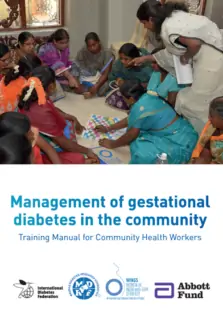
Guideline
Management of gestational diabetes in the community
A training manual for community health workers, developed as part of the IDF Women in India with GDM Strategy (WINGS).
attachments-58.pdf
pdf
1,017KB

Guideline
Having a baby? Now is the time to learn more about gestational diabetes
An educational manual with information and advice on having a healthy baby.
attachments-59.pdf
pdf
1MB
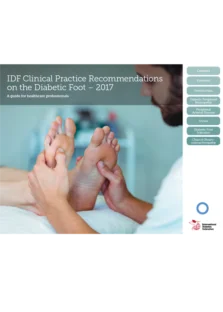
Guideline
IDF Clinical Practice Recommendations on the Diabetic Foot 2017
Simplified and easy to digest guidelines for health professionals, aimed at prioritising early intervention in the diabetic foot with a sense of urgency through education.
attachments-61.pdf
pdf
6MB

Guideline
Diabetic Foot Screening Pocket Chart
Pocket chart with information for health professionals to identify, assess and treat diabetic foot patients earlier in the "window of presentation" between when neuropathy is diagnosed and prior to developing an ulcer. The content is derived from the IDF Clinical Practice Recommendations on the Diabetic Foot 2017.
attachments-62.pdf
pdf
4MB
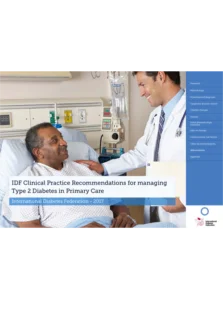
Guideline
IDF Clinical Practice Recommendations for Managing Type 2 Diabetes in Primary Care
Published in 2017, these Clinical Practice Recommendations for healthcare professionals summarise current evidence around optimal management of people with type 2 diabetes.
T2D-primary-care.pdf
pdf
3MB
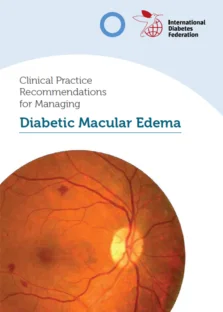
Guideline
IDF Clinical Practice Recommendations for Managing DME
Diabetic Macular Edema (DME) is a potential complication of diabetic retinopathy that currently affects more than 28 million people with diabetes. These Clinical Practice Recommendations are intended to facilitate the work of general practitioners, hospital physicians, and other clinicians working in diabetes-related eye disease management.
Clinical Practice Recommendations for Managing DME
pdf
408KB
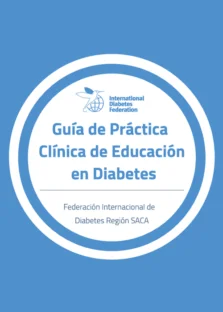
Guideline
IDF SACA Clinical Practice Guideline on Diabetes Education
Produced by the IDF South and Central America (SACA) Region with the aim of standardising evidence-based educational practices to improve the health and well-being of people with diabetes.
attachments-64.pdf
pdf
2MB

Guideline
IDF WPR Diabetes Care and Disasters Manual 2nd Edition 2022
This manual identifies means to reduce the negative impact of natural disasters and promotes the sharing of knowledge to increase community resilience to natural disasters. The second edition includes substantial updates informed by recent disaster experience learnings.
link to https://idf.app.box.com/s/pno1bkxgb9814w1hqkumvcg6q4vbxj2i
Download

Guideline
iCaReMe registry: CRF completion guideline
This guideline explains step-by-step how to use the iCaReMe electronic case report forms (CRF), which gives real-world data for healthcare professionals on patient management and quality of care.
CRF Completion Guideline
pdf
6MB

Guideline
iCaReMe registry tool: RWE Box
The RWE (Real World Evidence) Box is the iCaReMe registry data capture, management and analytics tool. It enables clinical, medical and real-world evidence research.
RWE Box Introduction 2021 (1)
pdf
4MB
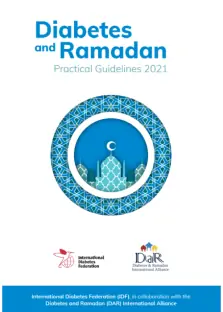
Guideline
Diabetes and Ramadan: Practical Guidelines 2021
These guidelines are intended to provide real-world recommendations to health professionals to support people with diabetes who choose to fast during Ramadan.
IDF_DaR_Practical_Guidelines_Ramadan
pdf
12MB

Guideline
Diabetes and Ramadan: Guide to a Safe Fast
This guide for people with diabetes who choose to fast during Ramadan provides information on the associated risks and complications of fasting and tips on blood glucose monitoring during a fast.
link to https://idf.org/media/uploads/2024/08/DAR-guide-to-safe-fast-EN.pdf
pdf 350kb